Bright pink nebulae encircle spiral galaxy NGC 922 in this image from the NASA/ESA Hubble Space Telescope. Credit: NASA/ESA. Zoom: John Williams/TerraZoom and Zoomify
Galaxies pack a wallop. A galactic bulls-eye ringed with pink nebulae is the only evidence of a rare galactic collision of NGC 922 that occurred millions of years ago. Clicking the button on the far right of the toolbar will allow awesomecosmicsauce to tantalize your eyes and work all of the pixels on your computer screen. Pressing the “ESC” will return you to the present universe.
Explore this awesome image from the NASA/ESA Hubble Space Telescope. While lovely, something is amiss in this image. NGC 922 used to be a spiral galaxy. As you zoom across the image, the spiral arms look distorted and disrupted. Hints of a galactic interaction are strewn across the galaxy from the large numbers of bright pink nebulae and blue stars to the spray of dim stars toward the top of the image. Ripples set up as the smaller galaxy passed through the gas and dust clouds of NGC 922 created new star formation. Ultraviolet radiation from these bright new stars cause hydrogen gas in the surrounding nebula to glow a characteristic pink. The tugs of gravity hurled thousands of stars outward.
Episode 60 of the Hubblecast explores NGC 922, a galaxy that has been hit square-on by another. Ripples of star-formation are still propagating out across thousands of light-years of space over 300 million years after the collision, making it a prime example of what astronomers call a collisional ring galaxy.
Scientists believe that millions of years ago a small galaxy, known as 2MASXI J0224301-244443, plunged through the heart of NGC 922. Sometimes, if a small galaxy hits a larger galaxy just right, a circle is formed. But more often than not, galaxies are not aligned perfectly. When a galaxy smacks another off center, one side of the ring is brighter than the other. NGC 922 is a prime example of what astronomers call collisional ring galaxies. Although only a few ring galaxies are seen in our cosmic neighborhood, of which the Cartwheel Galaxy is the most spectacular, ring galaxies appear to be commonplace as we peer further into the past.
As you explore the empty places of the image, look for faraway background galaxies. Several dim spiral galaxies dot the image both outside the galaxy and within the star-speckled interior.
NGC 922 is found about 330 million light-years from Earth toward the constellation Fornax. Sky mapper and French astronomer Nicolas Louis de Lacaille introduced Fornax, the Furnace, in 1756. Fornax is relatively devoid of stars allowing astronomers to peer deep into the universe. The constellation was the perfect target for the Hubble Ultra Deep Field image.
NASA/ESA Hubble Space Telescope image of NGC 922. Credit: NASA, ESA
Source: ESA Hubble

